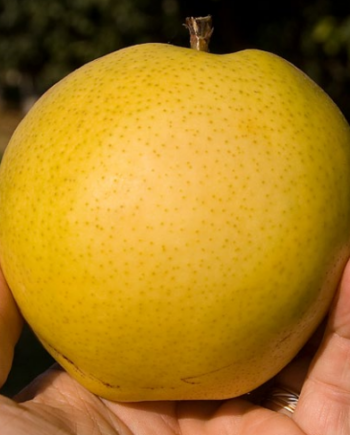Hood Pear Tree
The Hood pear tree produces large size, yellow-green fruit. The flesh is mildly flavored with a unique aroma. A very popular Asian pear, the Hood pear trees need very low chill (1-200 hours). Very resistant to fire blight. Pollinated by other Asian pears, especially Flordahome pear. USDA Zones 6-10. A very strong tree that produces many fruits that are good for eating.
Hood pear trees produce well in the mild winter climates of Los Angeles, Santa Barbara, and Orange County. Cold tolerate to most of the United States down to USDA Zone 6.
Not compatible with your zone (2a)
General Plant Information
Hood Pear Tree Information and Care
Grow your own strong and sturdy Hood Pear tree and produce many fruits. Trees grow 10-20 feet tall and wide and lose their leaves in the Winter. No additional water is needed while dormant in the Winter. Begin to water in the Spring once trees leaf out. Increase the frequency as it warms in the summer and reduces in the fall as it cools. Discontinue water during the Winter.
Fertilize you pear tree with organic fruit trees fertilizer seasonally. Use a higher nitrogen fertilizer such as manure and blood meal during the growing season. Also, apply fertilizers like a bone meal with higher phosphorus and potassium during the winter to promote spring blossoms.
Use organic fruit tree dormant sprays like Neem oil in the winter to prevent soft-bodied insects. Harvest fruit when ripe to prevent pests. Cover your crop with netting to discourage pests.
Additional Information
Sun Exposure : Full SunWatering : Regular
USDA Hardiness Zones : 6-10
Bloom Time : Spring
Harvest Time : Summer
Plant Type: Deciduous
Pollination: Self-Fruitful / Self Pollinating
Chill Hours: Less 100 hours below 45°F
Planting Information
Soil and Planting: Plant in soil that drains well. Dig a hole that is as deep as the tree’s roots and at least twice as wide.
Place the tree in the hole and backfill around the plant’s roots with a mixture of the native soil and high-quality planting mix that has washed sand and organic fertilizer.
Create a basin around the roots drip zone so that water collects. Water deeply until the roots and nearby soil is saturated and reaches field capacity.
Plant Care Information
Limited Guarantee and Returns
Compatibility
The two factors that determine if a deciduous fruit trees will grow well and produce fruit in a certain area are the Chill Hour Requirement and the Cold Hardiness. “Chill hours” are the amount of cold a deciduous fruit tree need to produce fruit. This is measured in the number of hours below 45 degrees Fahrenheit a plant must experience during its winter dormancy. Paradise Nursery only grows Low Chill fruit trees that meet the chill requirements of all areas of the United States.
The second factor is Cold Hardiness. Cold Hardiness refers to the minimum temperature a plant can tolerate. The USDA’s Cold Hardiness Zones indicate the average minimum winter temperatures of areas. Based on the shipping zipcode, our website will only allow you to add plants to your cart that grow within your USDA Hardiness Zone, and tolerate your climate.
Pollination & Propagation
(Grafting/Cutting) Most of Paradise Nursery’s edible plants are self-fruitful. Self-pollinating trees do not require an additional tree to produce fruit. For your convenience, we have indicated which trees require a pollinator, and their associated pollinators. Only the sweet cherries, avocados, and some plums require a pollinator. All of our other propagated edible plants do not require a pollinator. All of our edible plants are either grown from cuttings, budded, or grafted. This way, we can ensure that our plants are high quality and fruit immediately. Plants will generally begin fruiting within a year of planting.







